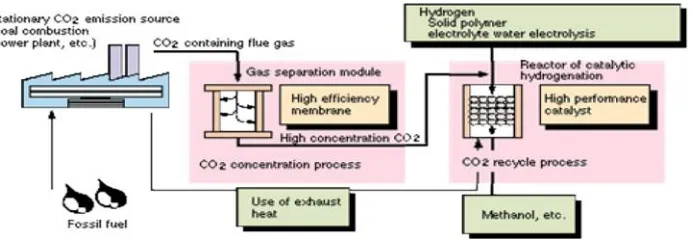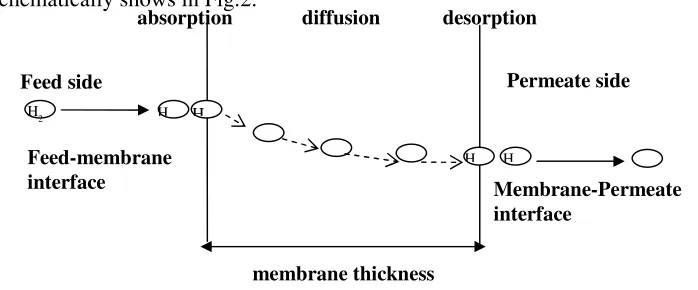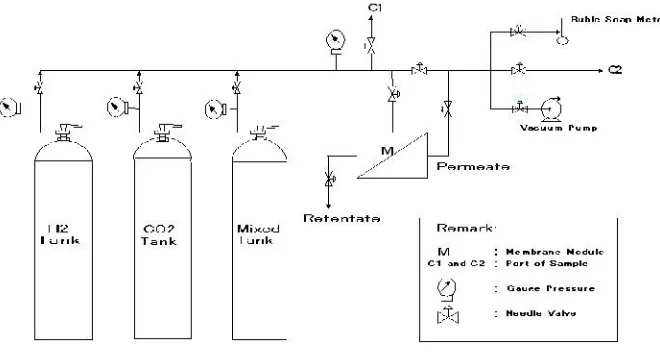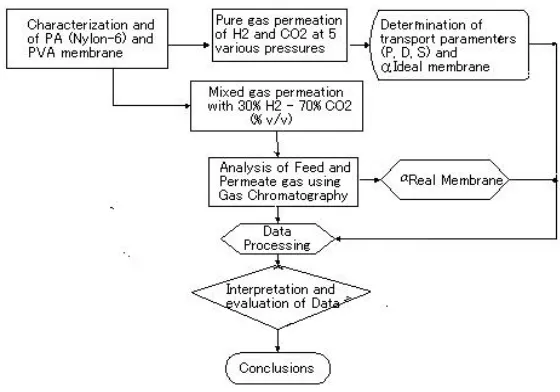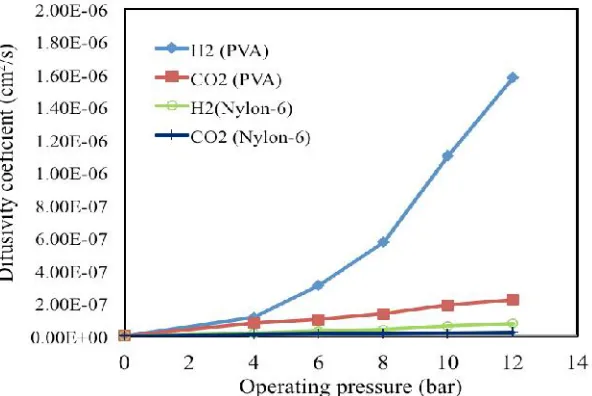Jurnal
A study of gas permeation on a polymeric membrane: permeability, diffusivity, solubility, and its performance for H2/CO2separation
FACHRUL RAZI
Departement of Chemical Engineering, Syiah Kuala University Jln. Tgk. Syech Abdul Rauf No. 7, Darussalam, Banda Aceh, 23111, Indonesia
E-mail: fachrurazi@che.unsyiah.ac.id
Abstract
The gas permeation on a polymeric membrane for H2/CO2separation in accordance to the solution-diffusion mechanism was studied. A commercial Polyvinyl alcohol (PVA) and Polyamide (nylon-6) membrane were used for pure and mixed gas permeation experiment and the interaction effects of the permeance gas with these polymeric membranes were observed by determining transports parameter such as permeability coefficient (P), diffusion coefficient (D), and solubility coefficient (S). Two-steps experiments were carried out:(1) pure gas permeation of H2and CO2, and (2) mixed gas permeation of H2-CO2(30 % H2- 70 %-v CO2). The operating pressure was varied in the range from 4 to 12 bars. Membrane performance on a gas separation was represented by
permeation flux (J) and its selectivity factor (α). The experiment result showed that
solubility of CO2 in PVA was greater than Nylon-6 membrane and decrease with an increasing operating pressure. Permeability and permeation flux of H2 were higher at both two types of membrane while the selectivity of H2/CO2 of nylon-6 membrane was higher in compared to PVA membrane.
keywords: gas permeation, polymeric membrane, polyvinyl alcohol, polyamide, permeability, diffusivity, solubility, selectivity
1. Introduction
The increasing of gas emission such as CH4and CO2 on the atmosphere
due to extensive oil usage generates substantial greenhouse gases. They caused a
serious problem such as the climate change due to global warming effect (Powell
et al., 2006) and thus, it needs an appropriate method to reduce CO2emission (Gu
et al., 2012, Brunetti et al., 2010, Merkel et al., 2010, Zhao et al., 2008). Morever
an affordable, clean and reliable energy supply such as hydrogen, is a major
global concern as the world’s fuel composition increases rapidly due to increased
industrialization and human population (Shao et al., 2009, Feng et al., 2002). So,
there exists an urgent need to shift the world’s consumption of energy from fossil
Among various separation methods, membrane technology have been
proposed as the new methods to reduce gas emission from various sources like as
coal combustion, power plant, and from vehicle exhaust gas as shown in Fig.1.
Figure 1. Recovery of CO2and its utililization by membrane separation
This figure shows that CO2 is separated from stationary CO2 emission
sources and used as a synthesize gas for methanol production. Gas permeation
membranes are well-established and fast growing in industrial technology.
Membrane systems are effective at separating O2from N2, CO2and H2S from CH4
and higher alkenes, and H2 from N2, hydrogen separation from its mixtures with
other gases like methane, carbon monoxide and nitrogen in syngas ratio
adjustment or in hydrogen recovery from hydrocarbons in refineries.
Although many types of membranes can be utilized for hydrogen
purification or and CO2 separation, polymeric membranes are preferred by and
worthy of extensive study because of their lower material and fabrication cost,
ease of processability, and capacity for long-term operation at relative mild
operating temperatures and pressures. However, the separation process
mechanism for gas separation with membrane was not clearly understood. Thus,
the aims of this work is to study the separation process mechanism on pure and
mixed gas permeation of H2/CO2 within a polymeric membrane and their
interaction effects on gas separation performance. Firstly, the interaction effect
between the permeance gas and PVA and Nylon-6 membrane will be studied by
diffusivity and solubility coeficient, and the membrane separation performance in
described by a solution-difussion mechanism. In the solution-diffusion model
(Wijmans et al.,1995, Li et al., 2013, Kim et al., 2011) the permeants disolve in
the membrane material and then difuse through the membrane down a
concentration gradient. This model is usually comprised of three steps: (i) the
adsorption or the absorption at the upstream boundary commonly called the
sorption step, (ii) the difussion through the membrane and (ii) the desorption or
evaporation on the downstream side of membrane. The separation mechanism
schematically shows in Fig.2.
Fig. 2. Gas separation for non-pore membrane membrane
The driving force behind the transport process which involves sorption, difussion
and permeation is the gradien concentration beetwen two sides of the membrane.
This process is described by Fick’s laws of diffusiion which give the flux,
J, in the direction of the flow, the rate of concentration change, dc/dt, at any point
within the membrane. Fick’s first law are described by eq (1).
Where C is the concentration, t the time, D the diffusion coeficient and x is the
position within the membrane down the concentration gradient.
After a certain permeation time the steady-state is reached which implies that the
concentration is remaining constant at all points within the membrane and the flux
may be described by eq.(2)
J = D (C0-C1)/l (2)
Where C0 and C1 are the permeant concentration on the upstream and the
downstream side of the membrane thickness. In a system where a gas or a vapor
diffuses through a membrane, the concentration may be replaced by gas partial
vapor pressure, p0 and p1 on either side of the membrane, then J is usually
descrfibed by eq.(3)
J = P(p0-p1)/l (3)
Where P is the permeability coefficient. In a rubbery polymer, the molecule
sorption at low concentration is typically described by Henry’s law [27] and if the
diffusion cofficient is constant over the pressure range, the permeability
coefficient may be rearranged to give the eq.(4)
P = D.S (4)
Where S is the solubility coefficient. To determine the permeability and the
diffusion coefficient, the lag time is used as described in the following section.
2.2. Time-Lag method
When a gas is first admitted to one side of the dense polymeric sheet
membrane both flow rate and gas concentrataion into the membrane vary with
time. If the diffusing is continually removed from the low concentration side of
the membrane, and the permeation time is high enough, then the steady-state is
achieved and the curve of the amount of gas permeating through the membrane,
Q, against time t, tends to be a straight line describe by eq.(5) [28-30] and it is
According to Henry's Law, the relation of ammount of gas can be sorpbed has a proportional relation to its solubility and pressure as described by the following equation.
Ci= S. pi (6)
and the total amount of gas permeation fluxs, Qt, in cm3 (STP).cm2.s, can be be describes as:
Qt= V/A. (7)
Thus, by subtituting the eq.(7) into eq.(5) and by rearranging the eq.(2), (3), (4), (5), (6) and eq.(7), finally, we can get the final equation of gas permetion through a polymer membrane as described below.
then by manipulatingP/l,eq.(8)can be writedown as
V
By plotted the V/A.pion y-axis against t on x-axis, this gas permeation curve has
a slope (P/l) and an intercept,θ, commonly called lag time, on the t-axis given by
Regarding to this permeation curve, then the permeability coefficient (P) of
permeate gas can be obtained by multiplying the slope with the membrane
thickness. Where permeability coefficient is in cm3(STP).cm/cm2s.cmHg. The
permeability coefficient is also given in Barrer (1 Barrer = 1x10-10
cm3(STP).cm/cm2s.cmHg. The solubility coefficient (D) in cm2/s, can be
determined from the intercept of permeation curve and can evaluated from
eq.(10). Finally, the solubility coefficient, S, in cm3(STP)/cm3(Polymer) cmHg,
can be obtained from Eq.(4) or by dividing the permeability coefficient (P) with
diffusivity coefficient (D).
3. Materials and Method
Commercial polyvinyl alcohol (PVA) and a linier type of polyamide
membrane (Nylon-6) were used for pure gas and mixed gas permeation of
H2/CO2.The thickness and effective area of flat disk PVA and Nylon-6 membrane
are 50 m and 14.7 cm2, respectively. The moleculer structure of Nylon-6 and
PVA are shown in Fig.4 .
C C
H H
H OH n
Fig. 4. The moleculer structure of polymeric membrane: (a). Polyamide (Nylon-6) and (b). Polyvinyl alcohol (PVA)
Two stages experiment were conducted to compare the performance of PVA membrane and polyamide (Nylon-6) for pure and mixed gas separation of H2/CO2.
3.1. Pure gas permeation
Pure gas permeation of single gas of H2and CO2were performed using a
constant-volume/variable-pressure method at a various feed pressure and at an
ambient temperature of 25 ºC. The permeation gas apparatus for pure and mixed
Fig. 5. Gas permeation system apparatus
The gas permeation system are comprises of a piping line, a soap-buble
flow meter to measure the gas flux, Qt, and a membrane module which is consist
of a chamber that sealed onto a flast disk membrane via an O-ring and a non
woven stainless stell as a membrane support. In order to keep the air-free
condition in a gas permeation system before the gas permeation measurements,
both the feed and the permeate sides were evacuated to a vacuum condition. Then
by adjusting feed pressure, the permeation cell was pressurized with the gas of
interest (H2and CO2), so that a gas is allowed to permeate from the upstream to
the down stream at atmospheric pressure. All measurements with that gas were
then taken after a steady-state flux was observed. Fluxes were measured at
pressures of 4-12 bars. The fluxes of H2 and CO2 were determined for each
membrane. Permeability of the individual gases of each pressure was determined
from slope of pure gas permeation curve, and the diffusivity coefficient was
determined from its intercept and then the solubility coefficient was calculated
according to eq.(4).The ideal separation factor αi/jfor pure gas permeation can be
calculated by using the following equation (Morisato et al., 1999, Thomas et al.,
2009).
a i j =
(P/l)i
3.2. Mixed gas permeation
A gas cylinder consist of H2 and CO2 with the composition of 30-v% H2
and 70-v% CO2was used for mixed gas permeation. The operating pressures were
varied in the range from 12 to 14 bars. Feed gas pressure were varied from 4 to 12
bar while the downside pressure was at atmospheric pressure. The mixed gas
permeation experiment was conducted at room temperature. The experimental
flowchart of pure and mixed gas permeation is shown in Fig.6.
Feed gas and permeate gas composition were analyzed by chromatography gas
(GC). The fluks permation of mixed gas permeation can be obtained by measure
of mixed permeant gas volume when a steady state condition is attained. Then the
real separation factor of mixed gas permeation was calculated from the eq.(12)
a *
A/B
=
(
y
A/
y
B) / (
x
A/
x
B)
(12)
4. Results and discussion
4.1. Diffusivity, permeability and solubility coeficient of pure gas permeation
Fig. 7 shows the experimental results of pure gas permeation of H2and CO2at
various feed pressure. It is shown that permeability of H2and CO2 for both two
types of membrane increases with increasing of feed pressure. Permeate flux of
H2and CO2for the PVA membrane higher than for the PA (Nylon-6) membrane.
This is attributed to the fact that PVA membrane has a group of hydroxyl units
(-OH), therefore PVA membrane more hydrophilic, and also
(-OH) groups could make the PVA membrane more swollen, thus the gas
molecules can easily absorbed and diffused through membrane. The gradient
pressure also gave the great effect on the gas permeate. Generally, gas permeates
increase linearly by increasing gradient pressure. The permeate flux of H2is much
higher than CO2 because it has a higher rate permeate (P/l) both on PVA and
Nylon-6 membrane. Whereas the ideal selectivity (α) for H2/CO2on Nylon-6 and
PVA membrane increases with an increasing feed pressure.
Fig.7. Diffusivity of H2 and CO2 on PVA and Nylon-6 at various feed
Comparing the ideal selectivity of pure gas permeation, the slectivity of
Nylon-6 at the highest operating pressure was about 4.9 that is two times higher
than that of PVA membrane as shown in Fig.10.
Fig.8. Permeability of H2 and CO2 on PVA and Nylon-6 at various feed
operating pressures
Fig.9. Solubiliy of H2 and CO2 on PVA and Nylon-6 at various feed
Fig.10. Membrane performance on pure gas permeation. (a) Permeation flux (J)
and (b) Selectivity of H2/CO2
4.2. Permeate Flux and Real Selectivity (α)of mixed gas permeation
Figure 11 shows the experimental results of mixed gas. The flux increases
with increasing the feed pressure, whereas selectivity decreases with increasing
the feed pressure. These phenomena took place due to a couple effects interaction
among molecules gas of H2, CO2and membrane. Therefore, the gas molecules of
CO2and H2will diffuse simultaneously. We can compare that the real selectivity
(a)
of PA membrane at 12 bar is about 3.78 and slightly higher than PVA membrane
about 2.3. This because PA (Nylon-6) membrane have a rigid structure and
smaller free void volume. Thus, when the feed pressure increase, the polymer
matrix of PA (Nylon-6) became more compacted, which could lowered gas
diffusion through membrane.
5.
Conclusions
Fig.11. Membrane performance on mixed gas permeation. (a) PVA membrane
5. Conclussion
From the experimental results, it can be concluded that solubility
coefficient of CO2 in PVA membrane was greater than in PA (Nylon-6)
membrane, and decreased for increasing pressure. Permeability coefficient and
permeate flux of H2were higher at both two types of membranes. The selectivity
of H2/CO2by using PA (Nylon-6) membrane was higher both at pure permeation
and at mixture gas permeation compared to PVA membrane. For further
experiment, it is suggested to study about behavior of the actual mass transport of
molecule gas thorough membrane and to consider the effect of dual sorption and
dual diffusion on the gas separation.
6. References
1. Brunetti, A., F. Scura, G. Barbieri, E. Drioli (2010), Membrane technologies for CO2 separation,Journal of Membrane Science,359115–
125.
2. Feng, X., P. Shao, R.M.Y, Huang., G. Jiang., R.X. Xu (2002), A study of silicone rubber/polysulfone composite membranes: correlating H2/N2 and O2/N2 permselectivities, Separation and Purification Technology, 27, 211–223.
3. Gu, Y., E. L. Cusller, T.P. Lodge (2012), ABA-triblock copolymer ion gels for CO2 separation applications,Journal of Membrane Science, 423-424, 20–26.
4. Kim, H.W., H. B. Park (2011), Gas diffusivity, solubility and permeability in polysulfone–poly (ethylene oxide) random copolymer membranes, Journal of Membrane Science,372,116–124.
5. Li, P., T.S. Chung, D.R. Paul (2013), Gas sorption and permeation in PIM-1,Journal of Membrane Science,432, 50–57.
7. Shao, L., B. T. Low, T. S. Chung, A.R. Greenberg (2009), Polymeric membranes for the hydrogen economy: Contemporary approaches and prospects for the future,Journal of Membrane Science,327, 18–31.
8. Thomas, S., I. Pinnau, N. Dub, M. D. Guiver (2009), Pure- and mixed-gas permeation properties of a microporous spirobisindane-based ladder polymer (PIM-1),Journal of Membrane Science,333, 125–131.
9. Zhao, L., E. Riensche, R. Menzer, L. Blum, D. Stolten (2008) A parametric study of CO2/N2 gas separation membrane processes for post-combustion capture,Journal of Membrane Science,325, 284–294.
